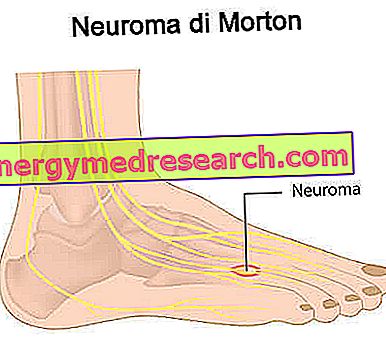Definition
Morton's neuroma is a disease that affects one of the interdigital sensory nerves of the foot. More specifically, Morton's neuroma is a type of fibrosis that develops on the nerve tissue that surrounds the interdigital sensory nerve in question.
The neuroma can affect any interdigital nerve, but - in most cases - the nerve to be affected is that between the third and fourth metatarsus.
Generally, this pathology affects patients between the ages of 40 and 50, with a higher incidence among female patients.
Causes
The exact cause of Morton's neuroma development is still unclear. Of course, the anatomy of each individual's foot is involved in the etiology of the disease. In fact, Morton's neuroma develops more easily in those subjects in which the space between one metatarsal and another is rather narrow, as there is a greater rubbing between the interdigital sensory nerve and the metatarsal bones.
The external risk factors that can facilitate the onset of the disease, on the other hand, are wearing shoes that are too tight and / or shoes with heels, traumas, repetitive stresses or the presence of any deformities in the feet.
Symptoms
Individuals with Morton's neuroma experience severe pain at the area where fibrosis developed. In addition, patients may experience a burning, numbness or tingling sensation.
Other symptoms that can occur are hypoesthesia, paraesthesia and swollen and tired feet.
Finally, at the nerve concerned, a slight depression may appear. In some cases, however, one may perceive the presence of a mass due to the neuroma itself, or due to an associated synovial cyst.
Information on Morton's Neuroma - Drugs and Care is not intended to replace the direct relationship between health professional and patient. Always consult your doctor and / or specialist before taking Morton's Neuroma - Drugs and Care.
drugs
The first-line treatment of Morton's neuroma is conservative. To this end, the doctor may decide to prescribe to patients the use of special custom-made orthotics, whose job is to reduce the compression in the area where the neuroma has developed, increasing the space between the metatarsal bones.
Pharmacological treatment, on the other hand, involves the local administration of corticosteroid drugs (parenterally) and possibly local anesthetics, so as to decrease inflammation, and therefore pain, caused by rubbing between the affected nerve and the metatarsals. However, treatment with corticosteroids - especially if done at high doses and if continued for long periods - can cause damage to the tendons and ligaments of the foot. Furthermore, this pharmacological approach may not be entirely conclusive and, consequently, the pain may recur after some time.
Other therapeutic approaches for the treatment of Morton's neuroma are based on cryotherapy, physiotherapy or sclero-alcoholization.
In cases where conservative therapy is not effective, however, the doctor may decide to resort to surgical removal of the interdigital nerve affected by fibrosis.

Methylprednisolone
Methylprednisolone (Depo-Medrol ®) is a corticosteroid that can be administered via a local injection at the neuroma. It is available in pharmaceutical formulations in combination with lidocaine (a local anesthetic).
Local administration of methylprednisolone should only be performed by specialized personnel, as it is an extremely delicate operation.
The amount of drug to be used can vary in a range from 4 mg to 80 mg, depending on the severity of the disease and the patient's condition. Therefore, the exact dosage of medicine must be established by the doctor on an individual basis.
Dexamethasone
Dexamethasone (Soldesam ®) is also a corticosteroid that can be administered locally at the lesion of the interdigital nerve affected by the neuroma.
Also in this case, the injection must be carried out only by specialized personnel, due to the delicacy of the operation.
The dose of drug to be used and the duration of the treatment must be established by the doctor on an individual basis for each patient, depending on his condition, the severity of the disease and according to his response to the therapy itself.



